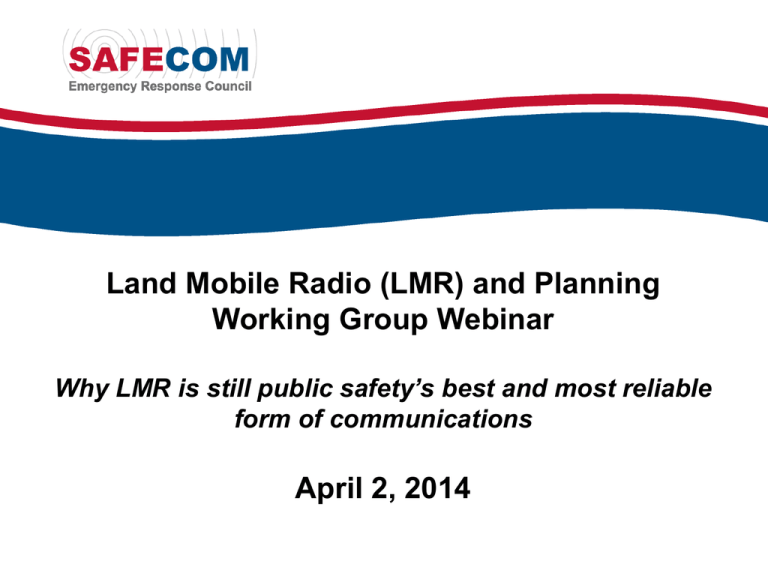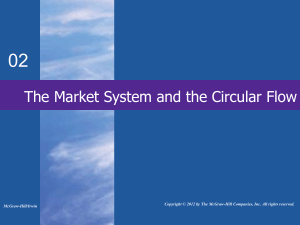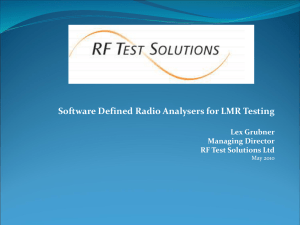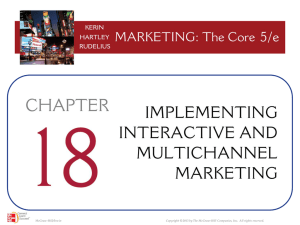LMR Systems - Amazon Web Services
advertisement

Document Title Land Mobile Radio (LMR) and Planning Working Group Webinar Why LMR is still public safety’s best and most reliable form of communications April 2, 2014 Welcome and Introductions Presenter Name Presenter Contact Information Website 1 Website 2 2 Agenda 1. Background 2. Importance of Land Mobile Radio to Public Safety Communications 3. Progression of Land Mobile Radio Technology 4. LMR Conventional and Trunked Network Equipment 5. LMR’s Provision of Critical Voice Communications 6. Key Advantages of Using LMR Systems 7. Why Can’t Public Safety Just Use Cell Phones? 8. Comparison of LMR and Cellular Long Term Evolution (LTE) 9. Public Safety’s Continued Use of LMR 10. Case Studies 11. Additional Resources 3 Background • SAFECOM is a stakeholder-driven, emergency communications program of the Department of Homeland Security’s Office of Emergency Communications (OEC) • SAFECOM was established in 2001 in response to emergency response interoperability deficiencies in the wake of September 11, 2001 • SAFECOM is coordinated by an Executive Committee, in support of the Emergency Response Council. The groups are primarily composed of State and local emergency responders and intergovernmental and national public safety communications associations • Both groups regularly convene to discuss interoperability, emergency communications, and provide input on the challenges, needs, and best practices of emergency responders 4 Background cont. • As a part of SAFECOM’s 2013 Strategic Priorities, the LMR and Planning Working Group was established to promote the continued use of LMR systems and educate constituents on the importance of sufficient funding to continue these systems, as our country simultaneously plans for the deployment of the envisioned Nationwide Public Safety Broadband Network (NPSBN) by the First Responder Network Authority (FirstNet) • The purpose of this webinar is to educate stakeholders on the continued use of LMR radio systems by highlighting and advocating the mission-critical capabilities first responders and emergency services providers rely upon everyday 5 Importance of LMR to Public Safety Communications • Over the past several decades, LMR has emerged as the primary voice communications tool for public safety • Current LMR systems are critical to the efficient provision of public safety services • Existing LMR systems must continue to be maintained, enhanced, and upgraded • Emerging voice services (e.g., IPbased, VoIP, VoLTE) available on wireless broadband networks do not currently provide the same capabilities, features, and functionality available from LMR 6 Progression of Land Mobile Radio Technology • Over the decades, the progression of LMR technologies from conventional analog systems to the current digital trunk systems can be largely attributed to overall advancements in electronics technologies • Project 25 (P25) standards further enhanced features and functions and are applicable to conventional digital and trunking LMR systems 7 SAFECOM Interoperability Continuum • The Interoperability Continuum is designed to help emergency responders and policy makers address critical elements for interoperable success • The goal is to move from the minimal standards, (left side) of the continuum, advancing to the maximum standard (right side) • Displays the progression of LMR technology in public safety 8 LMR Conventional and Trunked Network Equipment • Current systems include: • Handheld portable radios • Mobile radios • Base stations • Console equipment • Repeaters • Tower sites and backhaul • LMR systems are primarily designed to provide critical voice communications • Many existing conventional and trunked LMR offerings also provide support for nonbroadband low speed wireless data transmissions 9 LMR’s Provision of Critical Voice Communications Current Public Safety LMR technologies provide first responders with reliable, redundant, and flexible mission critical voice communications. These capabilities* may include: • Direct mode/Talk around: Capability of radios to communicate voice when out of range of the system/network infrastructure, when infrastructure has been damaged or destroyed, or when communications between units is desired or required off of the network infrastructure • Push-to-talk (PTT): Ability to transmit a voice message by pushing a button on the radio, creating a reliable, robust and almost instantaneous (subsecond) voice path connection with other subscriber devices • System/Group/Unit call: Allows users selectively to communicate on a oneto-many, one-to-selected group, or one-to-one basis between system-specific users • Radio device identification: Allows the display of the unique ID or assigned ID alias associated with the radio that also facilitates additional services such as emergency alert, private calls, deactivation of stolen radios and over-theair rekeying (OTAR) and over-the-air-reprogramming (OTAP) *Features and functionality not present in every type of legacy system 10 LMR’s Provision of Critical Voice Communications – cont. • • • • Emergency alerting: Capability that allows a user to actuate one button to transmit an emergency alert to other radios on a channel/talkgroup and to a controlling telecommunicator in real-time from first responder’s radios, sometimes referred to as the “emergency” or “officer down” button Priority: Ability of the LMR trunking system to differentiate access to system resources and services through the assignment of priorities based upon the user, radio, talk group/channel, or a feature such as an emergency or priority override function on a radio or console Encryption: Ability to convert voice or data transmission into a secure format to minimize unauthorized access Audio noise reduction technologies: Ability to hear audio in adverse conditions without repetition of the message. For example, an emergency responder must be able to hear voice communications regardless of background noises, such as sirens, chainsaws, mechanical noises, and selfcontained breathing apparatus *Features and functionality not present in every type of legacy system 11 LMR’s Provision of Critical Voice Communications – cont. • Dedicated channels/talk groups: Radio frequency resources that may emulate the structure of a user’s organization and provide almost instantaneous system/network access and quick response in emergency situations and do not require dialing and waiting for call connections • Highly reliable and redundant networks: Engineered and maintained to eliminate points of failure; incorporate redundancy, resiliency, and robustness to withstand natural/manmade disasters and other interruptive situations • Best possible coverage : Public safety LMR systems are commonly designed to provide the best possible radio frequency coverage within a given geographical area including a specific focus upon optimal in-building coverage • Public Safety LMR equipment: Uniquely designed equipment that permits prolonged operations in strenuous and rigorous environments that include the impacts of high/low temperatures, vibration, shock, liquid immersion, dust intrusion, and exposure to biological and chemical hazards 12 Key Advantages to Using LMR Systems • Efficient command and control – Public Safety LMR provides Incident Commanders (IC) the ability to separate and assign specific channel/talkgroup resources (within the limits of the system’s capacity) to critical functions at a large incident. At a major structure fire, the IC may assign channels/talkgroups to different operations consisting of groups of personnel executing assignments • Fast emergency response – Public Safety LMR is specifically designed to provide almost instantaneous assignment (< 500 milliseconds) of channel resources to a user in a trunked environment. There is no call setup time delay as is found in wireless telephony communications, and the established pathway can support one-to-one, one-to-group or one-to-many communications 13 Key Advantages to Using LMR Systems – cont. • Optimal crisis management and executive communications – Command personnel at large incidents can dedicate LMR resources (channels/talkgroups) that provide direct access and communications with other command staff. No lookup of telephone numbers is required, and multiple command personnel can monitor and provide a timely response via an established command resource • Communications resilience and redundancy – Public safety LMR systems are normally constructed and maintained to provide a higher level of user availability and accessibility. The infrastructure equipment and methods of deployment commonly implement hardened and redundant features to support the highest availability 14 Why Can’t Public Safety just use Cell Phones? Although they are both wireless networks, LMR and Cellular are quite different from each other • Priority – Commercial providers do not desire to routinely provide public safety with any priority for voice or data on their networks • Reliability (multiple points of failure) – Commercial systems are commonly not built to incorporate the same robustness found in public safety LMR systems (Best Effort vs. Mission Critical) • Disasters – Multiple incidents illustrate that a commercial system’s capacity is routinely overwhelmed • Talk Around – Present technology employed in commercial networks does not provide an “off network device-to-device” capability • Ruggedness – Consumer grade devices are not designed for continued use in the public safety/first responder environment 15 Comparison of LMR and Cellular LTE There are substantial differences in the technology, deployment, and operations of Public Safety LMR and Commercial Cellular LTE systems in typical deployments LMR Systems High Level Antenna Sites Fewer Sites for Coverage High Power Transmission Transmits as Needed (PTT) 20-40 Miles Coverage Omni-directional, directional Antennas High Power Mobile/Portables (5-100 W) Talk Around/Simplex Capable Channel Control/Selectable by User Wireline, RF, Fiber, Microwave Backhaul Typical Trunk Site Backhaul – Single T-1 Non-sophisticated Networks (Exception Trunked Networks/Sites) 8-12 Hours Device Battery Life LTE Systems Low Level Antenna Sites More Sites for Coverage/Capacity Low Power Transmission Active Connections 1-3 Miles Coverage Sectored Antennas, supports MAS, MIMO Low Power (200 mW) Devices Infrastructure Dependent Channel Control via Network Fiber, Microwave, Cell Frequency Backhaul LTE Cell Sites – Gigabit Ethernet Smart Cell Sites/Smart Network Core Device Battery Life Dependent on Data Use Red designates radio frequency / radio access network Blue designates site backhaul and site connectivity 16 Public Safety’s Continued Use of LMR Significant strides have been made in recent years to improve and ensure interoperability between disparate LMR systems and technologies LMR has traditionally and continually been embraced by the Public Safety community; significant investment in infrastructure and institutional knowledge; systems configured to topology and usage patterns through decades of use, evaluation, and adjustment 17 Public Safety’s Continued Use of LMR – cont. Although public safety personnel regularly use cellular phones, smartphones, tablets and other devices supported by commercial wireless services as an adjunct capability, many of these devices and networks are not yet sufficiently suited for public safety mission critical communications Public safety officials cannot depend on “best effort”, shared, commercial wireless systems. Such systems are often overloaded and unavailable during critical incidents when capacity demands overwhelm the networks 18 Public Safety’s Continued Use of LMR – cont. The public safety community is well immersed in LMR technologies; the change to the next "best thing" must be deliberate, proven, and capable of providing required features and functionalities available in current offerings while incorporating new capabilities At present, there is no other viable choice to achieve the same level of mission critical voice capabilities currently provided by Public Safety LMR Mission critical public safety grade voice communications is not possible in the current version of LTE and there is no target date for adding it to the NPSBN. Thus, the NPSBN is not a replacement for LMR 19 Case Study: San Diego Wild Fires Utilizing LMR to its full potential led to seamless communications and interoperability Lessons Learned San Diego and Imperial Counties have an expansive Regional 800 MHz Communications System with excellent user support and management through the San Diego County Sheriff’s Department Very little difficulty with communications other than some issues that normally would be expected of a large emergency incident The broad governance body is a robust user/guidance group that establishes and maintains SOPs and other systems usage and guidance documents 60+ agencies in San Diego and Imperial Counties use these interoperable resources on a daily basis, facilitating LMR communications across Federal, State, and local agencies 20 Case Study: Dallas-Ft. Worth Tornados – April 3, 2012 21 separate tornadoes struck the DFW area causing widespread damage and emergency responses from many area public safety agencies Lessons Learned The storms caused severe congestion on the commercial cellular systems serving the DFW area, impacting both voice and data call completion Numerous public safety agencies use commercial 3G/4G wireless data services for their first responder wireless communications services o Public safety wireless data communications, in many areas, were unusable for hours as there is no available priority access for public safety users and these shared commercial systems’ capacity was overwhelmed LMR mission critical voice systems continued to operate without interruption 21 Case Study: Superstorm Sandy – October 22, 2012 Public safety’s redundancy and resiliency requirements are not the same as those of commercial providers Lessons Learned Public safety agencies in the affected areas were able to maintain critical LMR communications in the aftermath of the storm In New York City — hit particularly hard by the storm — public-safety communications remained operable the entire time LMR infrastructure hardening to withstand hurricane conditions and the provision of emergency generators and backup power maintained LMR systems when the commercial electric grid failed The FCC reported that 25% of commercial cellular sites were not operational in the immediate aftermath of the storm 22 Case Study: Boston Marathon Bombing – April 15, 2013 Upgrades to communications technology in the years following the Sept. 11, 2001, attacks allowed for reliable voice contact among first responders. Lessons Learned LMR provided reliable service and seamless voice communication among Federal, State and local officials Boston’s reliance on commercial wireless carriers for public safety data access again demonstrated the need for a dedicated public safety broadband network. During first 90 minutes of the incident, saturation of cellular and landline phone services occurred State and local governments will also have to continue paying for their existing “land mobile radio” systems until broadband-based voice functions have been fully developed and proven reliable The City of Boston was very effective with its use of social media (i.e. Twitter), disseminating official information 23 Case Study: Los Angeles International Airport Shooting– November 1, 2013 Airport emergencies typically require a high degree of multiagency, multidiscipline, and public/private sector coordination to ensure effective responses Lessons Learned Aside from the normal confusion that typifies such incidents, non-interoperable radio systems caused gaps in cross-agency coordination Emergency alert and warning systems need to be updated and the technologies for 911 notifications to Airport Police must be better integrated While major efforts were made to use social networking and commercial media to inform the public, public mass notification within the airport was lacking 24 Additional Resources – SAFECOM Materials • SAFECOM Website: http://www.safecomprogram.gov/ • SAFECOM 2013 Annual Summary: • SAFECOM Fact Sheet: • SAFECOM Governance Charter: • SAFECOM Quick Reference Guide: • Video clip on why first responders will continue to rely on LMR technologies – Harlin McEwen: http://urgentcomm.com/land-mobile-radio/harlinmcewen-lmr-will-remain-public-safetys-best-choicemission-critical-voice-ne 25 Additional Resources – SAFECOM Materials cont. • NPSTC Brief: Why Can’t PS Use Cellphones for Mission Critical Voice Communications: http://psc.apcointl.org/wpcontent/uploads/Why-cant-PS-just-use-cell-phones-NPSTC041513.pdf • Article about LMR vs. Cellular for Public Safety: http://www.govtech.com/wireless/Why-Dont-Cops-Use-CellPhones.html?page=2 • NGA Wireless Interoperability Issue Brief: • NPSTC T-Band Report: • Impact of Non-P25 Digital Technology on Interoperability: http://www.rrmediagroup.com/onlyonline.cfm?OnlyOnlineID=4 32 • LAX Shooting After Action Report: http://www.lawa.aero/uploadedFiles/LAX/LAWA%20T3%20Aft er%20Action%20Report%20March%2018%202014.pdf 26 Document Title For questions and updates concerning the presentation, please contact: SAFECOMGovernance@HQ.DHS.GOV









